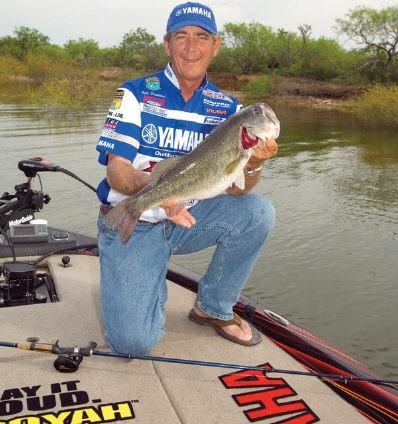 During the summer, bass tournament angler Zell Rowland often “chatters” to bass, especially when he first begins looking for them in shallow water. The Yamaha pro’s lure of choice for this technique is basically known as a chatterbait, a casting jig with a small, movable blade attached to the jighead that causes the lure to swim from side to side as it’s retrieved.
During the summer, bass tournament angler Zell Rowland often “chatters” to bass, especially when he first begins looking for them in shallow water. The Yamaha pro’s lure of choice for this technique is basically known as a chatterbait, a casting jig with a small, movable blade attached to the jighead that causes the lure to swim from side to side as it’s retrieved.
“When the original lure, actually named the Chatterbait, was introduced several years ago, it was an instant success, especially among the pros, so now many companies have similar lures, and the generic term for all of them is chatterbait,” explains Rowland.
“The blade, not quite as large as a postage stamp, wobbles but does not rotate, so it creates a lot of vibration and causes the entire lure to wobble from side to side like a crankbait. In shallow, stained or muddy water I think it’s a better lure choice than a spinnerbait.”
The wobbling blade does not make the lure weedless, so Rowland fishes it instead around the edges of different types of cover, such as bushes, grassbeds, lily pads, and even laydown logs. His preferred fishing depths with the lure are between one and five feet, but sometimes he’ll retrieve it just half an inch under the surface.
“These are easy lures for everyone to learn to fish because you basically use a continuous slow, medium, or fast retrieve without any jerks and pauses,” continues the Yamaha pro. “The lure’s vibration is so strong I believe it attracts bass to come investigate.
“The faster you retrieve, the shallower the lure runs. I’ve tried to fish it very slowly down to about 15 feet of water, but it’s not nearly as effective as it is in shallow water. The chatterbait’s real strength shows when you simply want to cover a lot of water in a hurry. You can work down a shoreline really fast and know if you don’t get any hits with the chatterbait that bass probably aren’t there.”
Matching the lure’s skirt color to dominant forage seems to be critical to fishing a chatterbait successfully, he adds. Favorite spinnerbait colors like white and chartreuse simply do not attract many bass.
“I can’t explain that,” concludes the Yamaha pro, “but I know I don’t catch many bass with a chartreuse/white skirt. I’ve done much better with whites and blues with a little orange mixed in, and I’ll often add a thin plastic trailer just to increase the action.”
Rowland fishes chatterbaits with 17 to 20-lb. fluorocarbon line and a medium/heavy action rod because of the quality of bass the lure does attract. He doesn’t catch a lot of truly big bass with it, just a lot of quality fish.

